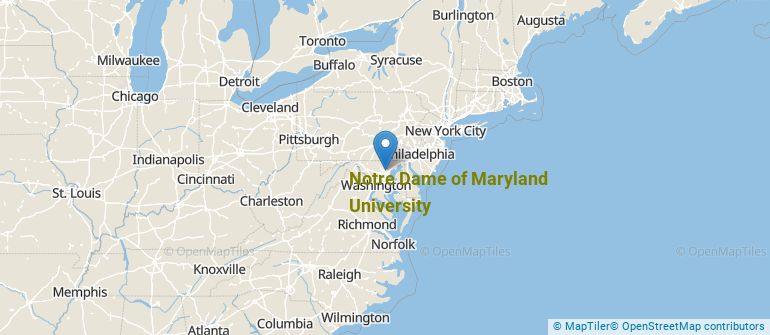 by our College Data Analytics Team
by our College Data Analytics TeamIn its yearly rankings, College Factual analyzes over 2,000 colleges and universities to determine which ones are the best in a variety of categories, such as overall value, quality, diversity, which schools are the best for each major, and much more.
Notre Dame of Maryland University was awarded 1 badge in the 2025 rankings. The highest ranked major at the school is health professions.
Explore the best ranked schools for the programs you are most interested in.
According to College Factual's 2025 analysis, NDMU is ranked #733 out of 2,152 schools in the nation that were analyzed for overall quality.
NDMU is also ranked #17 out of 35 schools in Maryland.
See all of the rankings for Notre Dame of Maryland University.
If you're applying to Notre Dame of Maryland University you'll face some tough competition, since the school's acceptance rate is only 70%. Definitely don't wait until the last minute to submit your application, since applying early may be in your favor.
The student to faculty ratio at NDMU is an impressive 8 to 1. That's quite good when you compare it to the national average of 15 to 1. This is a good sign that students at the school will have more opportunities for one-on-one interactions with their professors.
When estimating how much access students will have to their teachers, some people like to look at what percentage of faculty members are full time. This is because part-time teachers may not have as much time to spend on campus as their full-time counterparts.
The full-time faculty percentage at Notre Dame of Maryland University is 44%. This is comparable to the national average of 47%.
The freshmen retention rate is a sign of how many full-time students like a college or university well enough to come back for their sophomore year. At Notre Dame of Maryland University this rate is 62%, which is a bit lower than the national average of 68%.
The on-time graduation rate for someone pursuing a bachelor's degree is typically four years. This rate at NDMU for first-time, full-time students is 40%, which is better than the national average of 33.3%.
Find out more about the retention and graduation rates at Notre Dame of Maryland University.
During the 2017-2018 academic year, there were 755 undergraduates at NDMU with 563 being full-time and 192 being part-time.
| $0-30 K | $30K-48K | $48-75 | $75-110K | $110K + |
|---|---|---|---|---|
| $19,187 | $24,837 | $27,392 | $19,882 | $23,606 |
The net price is calculated by adding tuition, room, board and other costs and subtracting financial aid.Note that the net price is typically less than the published for a school. For more information on the sticker price of NDMU, see our tuition and fees and room and board pages.
While almost two-thirds of students nationwide take out loans to pay for college, the percentage may be quite different for the school you plan on attending. At NDMU, approximately 49% of students took out student loans averaging $7,396 a year. That adds up to $29,584 over four years for those students.
Get more details about paying for Notre Dame of Maryland University.

See which majors at Notre Dame of Maryland University make the most money.
Get more details about the location of Notre Dame of Maryland University.

Contact details for NDMU are given below.
| Contact Details | |
|---|---|
| Address: | 4701 N Charles St, Baltimore, MD 21210-2476 |
| Phone: | 410-435-0100 |
| Website: | www.ndm.edu/ |
| Most Popular Majors | Bachelor’s Degrees | Average Salary of Graduates |
|---|---|---|
| Nursing | 185 | $83,354 |
| General Education | 137 | NA |
| Teacher Education Grade Specific | 58 | NA |
| Pharmacy/Pharmaceutical Sciences | 49 | NA |
| Business Administration & Management | 43 | NA |
| Special Education | 31 | NA |
| Liberal Arts General Studies | 28 | $48,819 |
| General English Literature | 24 | NA |
| General Biology | 20 | NA |
| Other Multi/Interdisciplinary Studies | 15 | NA |
Online courses area a great option for busy, working students as well as for those who have scheduling conflicts and want to study on their own time. As time goes by, expect to see more and more online learning options become available.
In 2022-2023, 1,247 students took at least one online class at Notre Dame of Maryland University. This is a decrease from the 1,671 students who took online classes the previous year.
| Year | Took at Least One Online Class | Took All Classes Online |
|---|---|---|
| 2022-2023 | 1,247 | 915 |
| 2021-2022 | 1,671 | 1,138 |
| 2020-2021 | 1,356 | 840 |
| 2018-2019 | 698 | 317 |
Learn more about online learning at Notre Dame of Maryland University.
If you’re considering Notre Dame of Maryland University, here are some more schools you may be interested in knowing more about.
Curious on how these schools stack up against NDMU? Pit them head to head with College Combat, our free interactive tool that lets you compare college on the features that matter most to you!
Footnotes
*The racial-ethnic minorities count is calculated by taking the total number of students and subtracting white students, international students, and students whose race/ethnicity was unknown. This number is then divided by the total number of students at the school to obtain the racial-ethnic minorities percentage.
References
More about our data sources and methodologies.